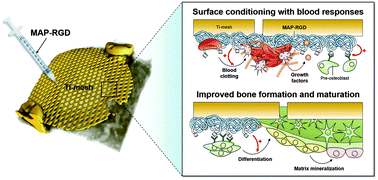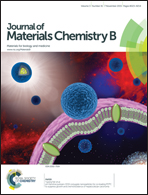Bioengineered mussel glue incorporated with a cell recognition motif as an osteostimulating bone adhesive for titanium implants†
Abstract
Successful titanium implantation strongly depends on early fixation through an osseointegration between the titanium fixture and adjacent bone tissue. From a clinical perspective, rapid recruitment of functional biomolecules from the blood and osteogenic cell binding is critical for osseointegration immediately after implant insertion. Thus, surface modifications aiming to improve the interactions between the blood and implant and to enhance the binding of osteogenic cells onto the implant surface can contribute to successful osseointegration. Mussel adhesive proteins (MAPs) derived from marine mussels have been considered as promising bioadhesives that have strong adhesion and coating abilities onto organic and inorganic surfaces, even in wet environments. Here, we investigated the in vitro and in vivo osteostimulating ability of the bioengineered mussel glue MAP-RGD, which is a recombinant MAP fused with an Arg-Gly-Asp (RGD) peptide, an effective cell recognition motif for activating intracellular signaling pathways, using a titanium mesh (Ti-mesh) as a model titanium implant. We found that the in vitro cell behaviors of pre-osteoblast cells, such as attachment, proliferation, spreading, and osteogenic differentiation, increased significantly on the MAP-RGD-coated Ti-mesh surface. In vitro blood responses including blood wetting, blood clotting, and platelet adhesion were also highly enhanced on the MAP-RGD-coated surface. Importantly, implantation of the MAP-RGD-coated Ti-mesh resulted in a remarkable acceleration of in vivo bone regeneration and maturation of a new bone in a rat calvarial defect. Consequently, the bioengineered mussel glue can be successfully utilized as an osteostimulating bone bioadhesive for titanium implant applications with further expansion to general bone tissue engineering.


 Please wait while we load your content...
Please wait while we load your content...